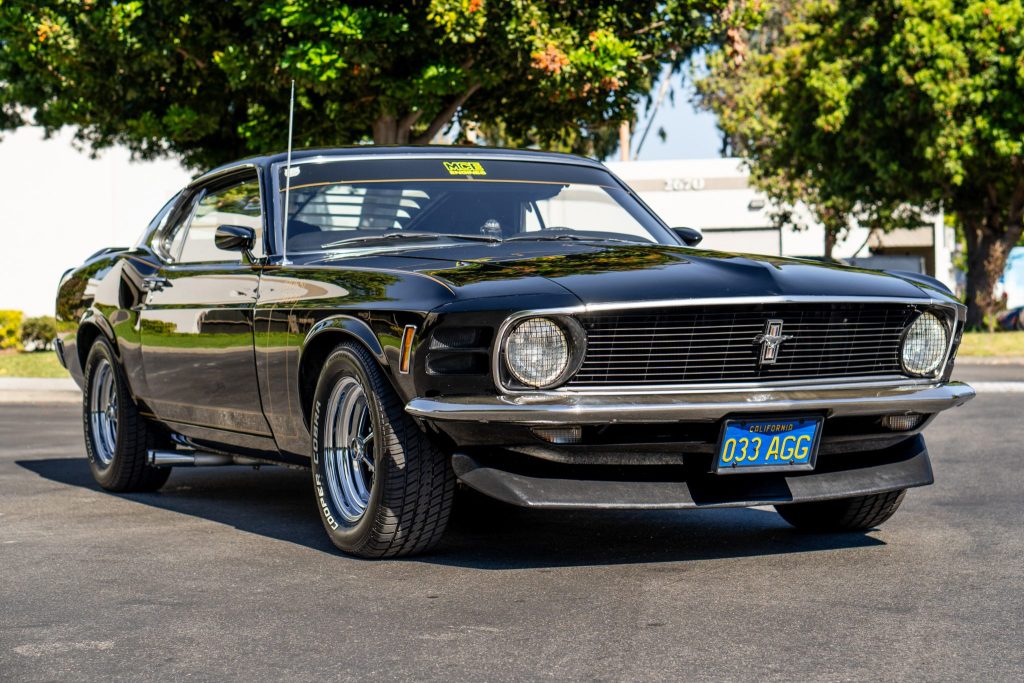

















Description
This 1970 Ford Mustang Boss 302 is fitted with a replacement 302ci V8 crate engine that was balanced and blueprinted by MCE in 1972 before being repainted black with gold Boss-style graphics as part of a refurbishment completed towards the end of the decade. The car wears H4 headlights with stone guards as well as a front air dam, a rear wing, and rear window louvers, while inside the black vinyl–trimmed seats are accompanied by a center console,…
This 1970 Ford Mustang Boss 302 is fitted with a replacement 302ci V8 crate engine that was balanced and blueprinted by MCE in 1972 before being repainted black with gold Boss-style graphics as part of a refurbishment completed towards the end of the decade. The car wears H4 headlights with stone guards as well as a front air dam, a rear wing, and rear window louvers, while inside the black vinyl–trimmed seats are accompanied by a center console, a Ford Aeronutronic AM/FM radio, and Speedwell auxiliary gauges. The engine is equipped with a 780-CFM Holley carburetor and mated to a four-speed close-ratio manual transmission, and further equipment includes a Hurst shifter as well as a side-exit dual exhaust system with an H-pipe. Following a period of storage, the car underwent additional refurbishment work in 2024 that is noted to have involved re-coring the brass radiator, replacing the front brake discs, and installing 15″ Magnum 500-style wheels.
The car left the factory finished in Medium Blue Metallic paint and underwent a color change to black with gold Boss-style graphics as part of the aforementioned refurbishment completed in the late 1970s. Headlight stone guards protect the H4 halogen headlamps up front, and further details include a replacement front air dam as well as a rear wing, rear window louvers, and dual sport mirrors.
The 15″ Magnum 500-style wheels were recently installed and mounted with 235/60 Cooper Cobra Radials tires. The car rides on Koni shocks, and braking is handled by power-assisted front discs and rear drums. The front brake discs and pads were replaced in 2024, and the removed 15″ steel wheels, hub caps, and trim rings are included in the sale.
The front bucket seats are trimmed in black vinyl and wear cloth covers. Three-point seatbelts are equipped up front, while lap belts accompany the rear bench. A compass is installed atop the dash, and further interior appointments include a floor-mounted center console, a heater, and a Ford Aeronutronic AM/FM radio.
A two-spoke steering wheel is paired with a Hurst shifter topped by an 8-ball knob. Instrumentation includes a 120-mph speedometer and an 8k-rpm tachometer flanked by coolant temperature and fuel-level gauges, while centrally mounted Speedwell gauges indicate vacuum and oil pressure.
According to the seller, a replacement 302ci V8 crate engine was balanced and blueprinted by MCE of Los Angeles, California, before being installed in November 1972. A modified 780-CFM Holley carburetor has been added, and the removed unit will accompany the car. Recent work is said to have involved re-coring the brass radiator and replacing the battery.
Power is sent to the rear wheels through a four-speed close-ratio manual transmission. The clutch assembly is said to have been recently replaced. The dual exhaust system retains a factory-style H-pipe ahead of an aftermarket side-exit system featuring twin polished outlets ahead of the wheels on each side of the car.
The Deluxe Marti Report shows initial delivery to Wilson Ford Sales and lists a production date of October 13, 1969, along with factory options and production statistics.
The removed engine is said to have been overhauled before being placed into storage in the early 1970s. It is included in the sale along with a collection of spare parts.
- 97k Chassis Miles Shown
- Replacement 302ci V8
- Four-Speed Manual Transmission
- Black Paint w/Gold Pinstripes
- Black Vinyl Upholstery
- 15″ Magnum 500-Style Wheels
- Koni Shocks
- Front Disc Brakes
- Ford Aeronutronic AM/FM Radio
- Speedwell Auxiliary Gauges
- Hurst Shifter
- Modified Holley Carburetor
- Side-Exit Dual Exhaust System
- Deluxe Marti Report
- Removed 302ci V8
- Additional Spare & Removed Parts








